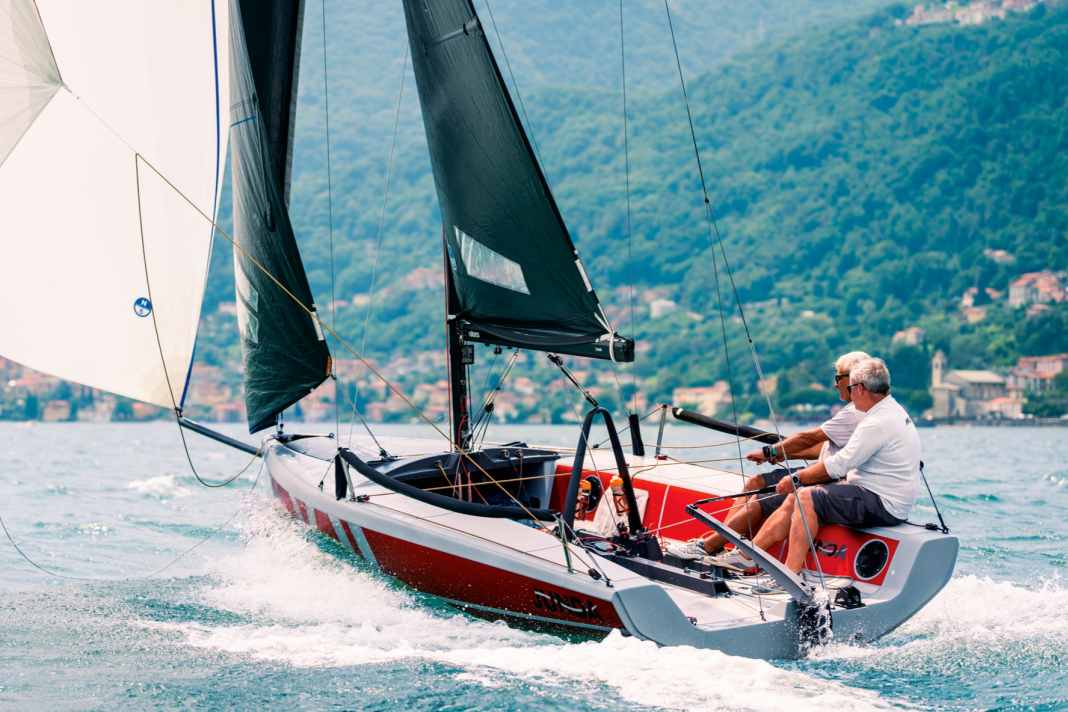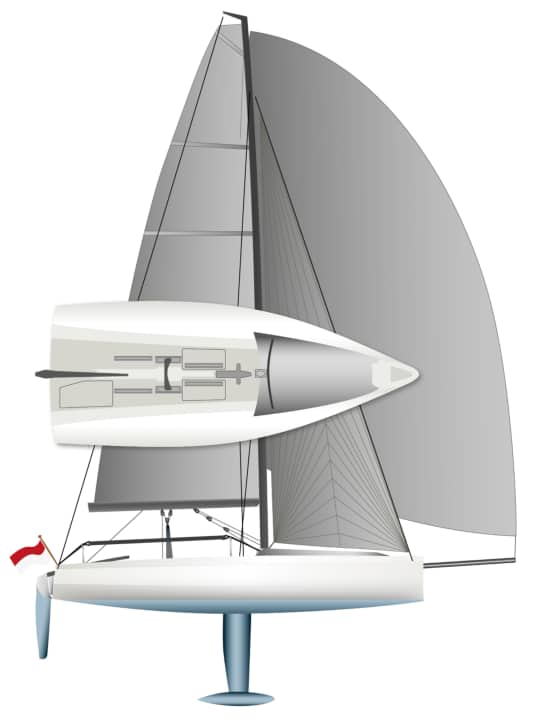Junda KII in the test: Exciting sports boat project designed as a two-man boat






The name suffix "KII" (K2) is a little intriguing and is reminiscent of the abbreviation "MKII", which is generally a common designation for a revised product in a new edition, even for boats. But no: in this case, both the boat and the brand are completely new. Project initiator Ludovico Fassitelli explains the somewhat peculiar term: the appendix KII stands for a keelboat with two people. And with that, the concept is already roughly sketched out.
Ludovico Fassitelli is at home in Monaco and a true sports boat enthusiast, active and successful in the established J/70 and Melges 20 classes, among others. However, Fassitelli has always been bothered by what he considers to be the overly complex way in which these boats are operated and sailed in the class. In particular, the constant search for a suitable crew of three or four co-sailors, the increasingly high level of professionalism and the associated cost intensity were and are a thorn in the side of the Monegasque.
Also interesting:
It has to be simpler, less complicated and cheaper. With these objectives in mind, the 59-year-old sportsman set about planning a fresh, uncomplicated but no less sporty concept. In collaboration with designer Umberto Felci, the result is an exciting little boat that ventures into an exotic niche, somewhere between a two-man planing dinghy and a sports boat with a keel. The focus of the idea is the rapid development of an internationally popular one-design class with an attractive regatta programme. Following the prototype, the first series boats are now under construction and several orders have already been placed.
The extremely strict class rules are also currently being finalised. According to these, the boat is to be sailed exclusively by two people at regattas, but without any restrictions on team weight. In order to maintain equal opportunities in the single class, the sailing wardrobe for the regattas is of course also strictly regulated.
Significantly more dinghy than keelboat affinities in windy conditions
The large lakes in northern Italy are notorious for their unpredictable wind conditions. This means that a gentle breeze can quickly turn into a serious chop without warning, as was the case during the YACHT test with the prototype on Lake Como. At the start of the test run, the wind was blowing at just six knots. That's enough to accelerate the Junda KII to a good 4.0 knots hard upwind.
Out of nowhere, the wind turns to the north and picks up, averaging up to 20 knots and 25 knots in strong gusts. Against the wind, the keelboat, which is only 5.80 metres long and weighs around 600 kilograms, still manages 5.5 knots, which is within the expected range. In fact, the Junda surprises with a solid height upwind. The tacking angles are between 70 and 75 degrees. Under gennaker, the electronics register a respectable top speed of 13.6 knots.
The Junda KII sails well-balanced and with a noticeably high degree of stability, thanks to the comparatively wide stern of the Felci construction with the pronounced chines that extend far forwards. Despite the very gusty wind conditions in the test, the small boat is easy to keep on the wind edge. The reactions are comparable to those of a dinghy.
In general, the boat is much more of a dinghy than a keelboat, especially in windy conditions, and wants to be sailed actively and physically. The crew has to move and pay attention to the weight trim in order to sail it at optimum speed. However, intensive hiking over the rail, as is common in many sports boat classes, should be prohibited in the standard class. The skipper and helmsman always sit with their legs facing inwards.
Divisible carbon fibre mast
The handling is good, the lines are easy to grasp and the number of lines is manageable in comparison. The 37 square metre gennaker can be set from a so-called launcher and with a single-line system. This means that the halyard, the jib line and the extendable bowsprit are linked together and are operated simultaneously with just one line. In the test, this works equally well and easily both when setting and retrieving.
The fixed bracket for the mainsheet guide in the centre of the cockpit is visually striking. The high sheet tension makes it possible to trim the main boom to the centre even without a traveller. However, a strong boom vang and a strong backstay are required to adjust the mainsail to all conditions. Both trimming aids are available on the Junda KII and, thanks to the good and high-quality deck equipment, are also functionally flawless. All cleats and blocks are supplied by Harken, and the halyards, sheets and trim lines are made of Dyneema and tapered where possible.
The T-shaped lifting keel is raised using a simple crane system and the rudder blade, beautifully constructed from carbon fibre, is foldable. This makes it easier to transport the Junda KII on the trailer, and launching and retrieving the boat via the slip ramp is also uncomplicated. The carbon fibre mast from Seldén can be joined in the middle and split for transport. In two pieces, the rig can then be easily transported under the boat on the trailer and does not need to be lashed to the boat with long overhangs. In addition, two boats can be stored completely in a 20-foot container, for example for transport overseas.
Innovatively designed motorisation system
The Junda KII is built at a shipyard on Lake Como. The hull and deck are built as sandwich constructions using a vacuum infusion process with epoxy resin. In addition, there are many beautifully built carbon fibre parts (mainsheet bows, footrests, rudder and tiller), supplied by a carbon specialist in Italy.
The highly innovative motorisation system is particularly worthy of praise. An electric outboard motor from Torqeedo is simply folded over the stern from a storage space at the stern using an ingenious mechanism. The drive is then operated using a lever switch installed under the massive mainsheet bracket, where it is well protected.
The ship costs 49,500 euros in this complete basic configuration. This corresponds to a gross price of 58,900 euros including 19 per cent VAT. In addition, the sails (main, jib and gennaker) cost around 7,000 euros gross. A new road trailer specially built for the boat is also available for just under 5,000 euros. The complete ready-to-race package therefore costs just over 70,000 euros - a lot of money for a boat of this size. However, the extensive basic equipment and the good build quality must also be taken into account.
Many modern sports boats are presented with the prospect of quickly establishing an internationally strong and widespread standardised class. But only a few achieve this goal. Whether the new Junda KII can achieve this remains to be seen. In any case, the concept is virtually predestined for this. And if not, what remains is an attractive, sporty boat in a manageable size and with a wide range of uses.
The measured values for testing the Junda KII



The Junda KII in detail

Technical data of the Junda KII
- Design engineer: Felci Yacht Design
- CE design category: C
- Torso length: 5,80 m
- Waterline length: 5,80 m
- Width: 2,30 m
- Draught (lifting keel): 1,60 m
- Theoretical torso speed: 5.8 kn
- Weight: 600 kg
- Ballast/proportion: 270 kg/45 %
- Mainsail: 12,3 m2
- Self-tacking jib: 7,0 m2
- Gennaker: 37,0 m
Price and shipyard
- Base price ex shipyard: 58.900 €
- Price ready to sail: 65.900 €
Status 2024
YACHT review of the Junda KII
Exciting sports boat project from Monaco, which is set to establish itself internationally as a new One Design. The orientation as a two-man boat is unusual
Design and concept
- + Strict One Design
- + Attractive size
- - Higher base price
Sailing performance and trim
- + Active sailing
- + Good height in the wind
- + Perfect handling for two
Equipment and technology
- + Carbon fibre mast divisible
- + Sophisticated motorisation
- + bracket for mainsheet guide

